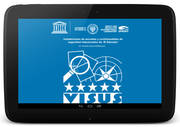School Safety Assessment: VISUS Methodology

©UNESCO\Jair Torres.
A team of lecturers, researchers, practitioners and student are conducting school safety assessment by field survey as part of their training in the VISUS methodology for school safety. Bandung, Indonesia (2015).
Ensuring the safety of people is one of the main concerns of public administrators in hazard-prone territories, particularly with reference to strategic and relevant major public buildings, such as schools. This requires the definition of a rational and effective strategy for risk reduction and climate change adaptation based on the level of risk, points of weakness, countermeasures and costs. Administrators and policy-makers must make decisions using a finite budget for a variety of safety interventions in schools of an entire district. Therefore, there is an imperative need for a quick but reliable assessment methodology, which allows them, on the one hand, to characterize the initial situation, and on the other hand, to support them with concrete information for decision making. Moreover, when a priority of intervention is necessary, a multilevel approach is also useful for facilitating the decision process to upgrade the safety level.
In close collaboration with UNESCO, SPRINT-Lab researchers at the University of Udine in Italy developed a specific technical-triage methodology named VISUS. This safety assessment methodology facilitates the decision-making process in the definition of rational and effective safety-upgrading strategies, and allows decision makers to take science based decisions on where and how they may invest their available resources for strengthening the safety of schools, their students and teaching staff in an efficient and economical manner.

VISUS App
VISUS assesses schools in a holistic and multi-hazard manner that considers five issues: site conditions, structural performance, local structural criticalities, non-structural components and functional aspects. Each issue is analyzed using the process of an expert reasoning, splitting the assessment in two main phases: the characterization and the evaluation. As a result, simple graphical indicators summarize the evaluation pointing out the main weaknesses and the needs of intervention. The collection of data during the characterization phase is done through a mobile application.
The information generated will support the sustainability of the desired impacts as, i) Ministries of Education and Finance will be able to define and prioritize the budgets needed for future investments; and, ii) international and regional development banks can use the outcomes of the assessments to guide the design of future grants and loans for rehabilitation, reinforcement and retrofitting of school buildings, and in the construction of new safe schools.
Technical triage assessments and expert judgment pre-codification processes are the two main elements on which VISUS methodology is based.
Different levels of assessment can be identified aiming to answer different requirements. Low assessment levels are usually implemented through a collection of data (desk analysis, questionnaires, forms, check-lists, etc.). These approaches allow a quick ranking of buildings through indices. Nevertheless, such approaches cannot be detailed enough to properly answer all of the administrator’s concerns; and in most of the cases the quality of input data is not accurate. On the other hand, deeper analyses can answer the majority of administrator’s concerns, with in-depth/specific assessments, detailed design and cost quantification. However, these inspections are very costly, timely consuming and they rely on the available expertise within the country – which sometimes is inexistent – limiting the number of facilities that could be inspected.
Due to the specificities of the VISUS methodology, the methodology has been recently adopted by UNESCO and has been positively tested in several pilot projects.
- More information about the VISUS methodology
- Pilot projects:
- El Salvador (100 schools assessed in 2013)
- Laos (10 schools assessed in 2015)
- Indonesia (160 schools assessed in 2015-16)
- Peru (60 schools assessed in 2016)
- Haiti (100 schools assessed in 2017)
- Mozambique (ongoing, 100 schools assessed in 2017 from September to December)
The UNESCO-VISUS methodology was also used to help Antigua and Barbuda plan for recovery following hurricane Irma in 2017.




